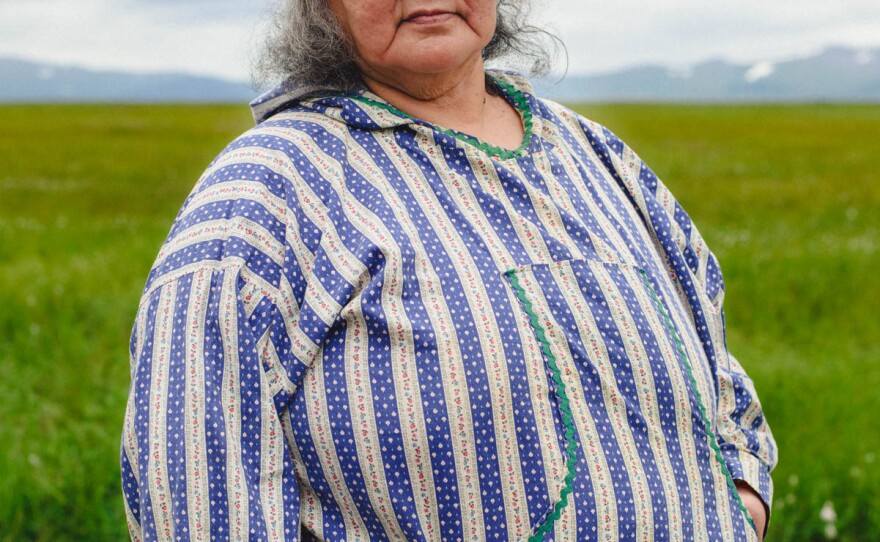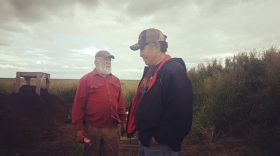Quinhagak took a big step to redraft its cultural narrative this month with the opening of the largest museum collection of Yup’ik artifacts in the world, located off the coast of the Bering Sea. The village has been regaining pre-contact cultural knowledge, leading to a deeper understanding of its Yup’ik heritage.
Elder Grace Hill speaks to a crowd of over 100 people packed shoulder to shoulder in the Quinhagak village corporation building on a cloudy Saturday afternoon. It’s August 11, and the community has gathered to celebrate the official opening of the Nunalleq Cultural and Archaeology Center.
The collection of over 60,000 artifacts, and counting, is owned and controlled by Qanirtuuq Inc., Quinhagak's village corporation. Elders have known about the old site at Nunalleq for some time. People were encouraged not to disturb the area, but artifacts began emerging as the permafrost thawed and the site eroded.
The University of Aberdeen, Scotland came in to help. The window to save the items was small, because most of the artifacts decompose quickly once unfrozen. What they found confirmed old stories handed down by elders of what they called the Bow and Arrow Wars, which took place hundreds of years ago.
Elder Grace Hill says that she’s glad the village corporation acted quickly to save the artifacts while keeping them under local control. Hill encourages other tribal communities to do as they’ve done, adding that it’s crucial that artifacts stay within tribal communities, as many items in the past have been taken to places like the Smithsonian Museum for other people to learn from outside the Yup’ik cultural context. Keeping objects in Quinhagak in the long run isn’t cheap, however.
“You know, most of those collections are organics, and so they need specialized skills to keep those maintained in a proper environment, and all of that,” said Archaeologist Steven Street, who works with the Association of Village Council Presidents.
The corporation is meeting with museum professionals and others in an effort to support the project long term.
The Nunalleq dig and the cultural center represents a pivotal moment for Alaska Native and Native American tribes nationally. Over the past decade, Quinhagak has built a rare relationship between academics and Native communities, succussfully pulling off one of the largest modern arctic excavations ever.
“It’s hugely important, especially to Native Alaskans and Native Alaskan communities, to have control and authority over their heritage, and it’s obvious that they want and need to tell their own story in their own way,” said Street, adding, “it’s all kind of up to them in this case, and so that’s huge for them.”
A massive rectangular hole sits on the edge of Kuskokwim Bay where two large sod houses once stood, one dating back 400, and the other 500 years. Alongside the people of Quinhagak, archaeologists are recovering artifacts that range from carved wooden masks and dolls, leather, feathers, baleen, bone, ivory, gut skin, and much, much more.
Qanirtuuq Inc. President Warren Jones says that the community, elders and children alike, have learned a lot over the last 10 years from their ancestors that they can pass on.
“I think the biggest reason I’m doing this, we’re doing this, is for our future generations," said Warren.
He says that the dig was started for their children so that they will never forget where they came from, and that they are not only excavating, they are finding out about everything. He hopes that youth will continue to engage and learn from their work there, with some going on to pursue higher education and coming back as archaeologists to run the project.
Until last year, parts of this collection were shipped to the University of Aberdeen in Scotland to be conserved properly. Last August, they opened up a laboratory on site, which has brought lab costs to preserve artifacts down considerably. The Nunalleq Cultural and Archaeology Center serves as a preservation and research facility, cultural education center, and museum. Archaeologist Rick Knecht, dig site manager of Nunalleq, says that they’re trying to break new ground on this project in the way that archaeologists engage with the community.
“People share their results, but it’s not the same as real power sharing here, and making joint decisions on how to approach an archaeological site, and dealing with the artifacts and interpretation and so on,” Knecht said. “What we’re trying to do is by working as equal partners to make sure that native voices are fully included in it, because we’re reconstructing the Yup’ik past here.”
A task, Knecht says, that can only be understood with the leadership of the Yup’ik community.
“It starts with planning a project that meets local needs and not just scientific needs, and more often than not you can meet both of those through a project, through a little consultation, and through a little planning. It takes a little extra time to do that, but it’s well worth it. The rewards are tremendous,” said Knecht.
For Elders like John Smith, a local carver who’s replicated many of the items dug out of the ground at Nunalleq, the rewards are in keeping with traditional Yup’ik values through passing down knowledge.
Smith says that it’s important through generosity and love to preserve and share the knowledge being gained at Nunalleq, where among other things, knowledge rediscovered in hunting tools can well mean the survival of those traditions and the hunters today.
Katie Basile, Jacqueline Cleveland and Teresa Cotsirilos contributed to reporting this story.
https://www.youtube.com/watch?v=LN0fgizw0og&feature=youtu.be
















